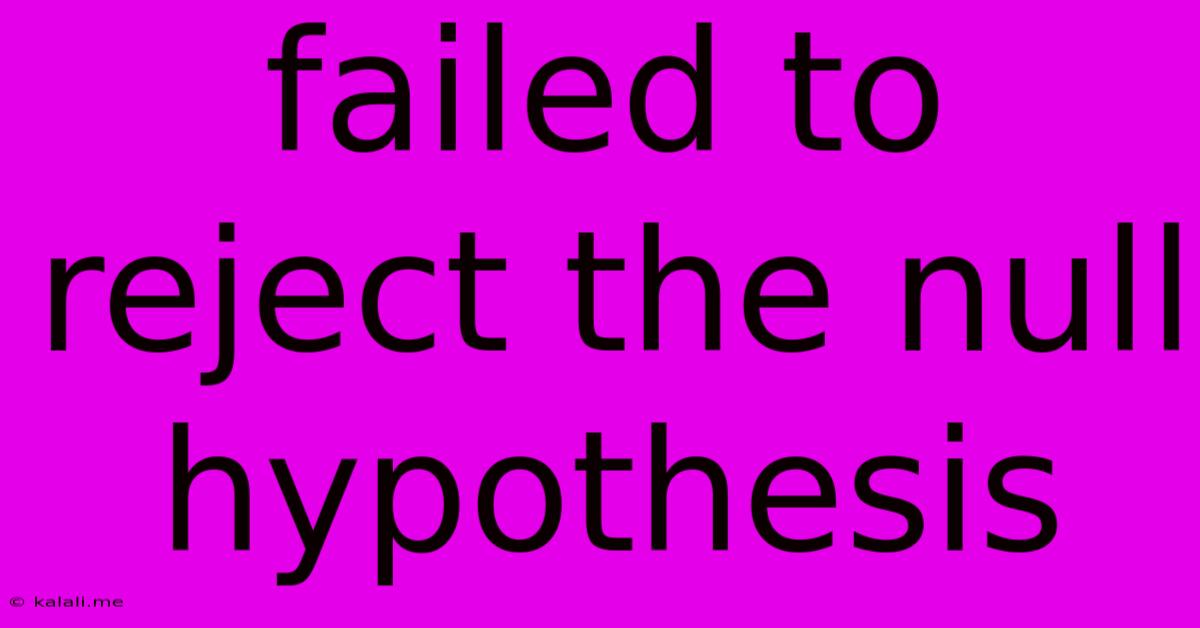Failed To Reject The Null Hypothesis
Kalali
May 29, 2025 · 3 min read

Table of Contents
Failed to Reject the Null Hypothesis: Understanding the Implications
Failing to reject the null hypothesis is a common outcome in statistical hypothesis testing, and it often leads to confusion and misinterpretations. This article will clarify what it means, the implications of this result, and how to properly interpret it in your research. Understanding this crucial concept is vital for accurately drawing conclusions from your data.
What is a Null Hypothesis?
Before diving into the implications of failing to reject the null hypothesis, let's briefly review the concept of the null hypothesis itself. In statistical testing, the null hypothesis (H₀) is a statement that there is no significant difference or relationship between variables. For example, in a study comparing two treatments, the null hypothesis might be that there's no difference in effectiveness between the treatments. The alternative hypothesis (H₁) proposes the opposite – that there is a significant difference or relationship.
What Does "Failed to Reject the Null Hypothesis" Mean?
When we say we "failed to reject the null hypothesis," it does not mean we have proven the null hypothesis to be true. It simply means that the data we collected did not provide enough evidence to reject it at our chosen significance level (usually 0.05 or 5%). There are several reasons why this might occur:
- The null hypothesis is actually true: There might be no real difference or effect to be found.
- The effect is too small to detect: The sample size may have been too small to detect a real, but relatively small, effect. A larger sample size might be needed to achieve sufficient statistical power.
- There were problems with the study design: Issues with the experimental design, measurement errors, or confounding variables could have masked any real effect.
- The statistical test was not appropriate: The chosen statistical test might not have been the most appropriate for the type of data collected.
Implications of Failing to Reject the Null Hypothesis
The implications of failing to reject the null hypothesis are often misunderstood. It's crucial to avoid concluding that the null hypothesis is definitively true. Instead, consider these interpretations:
- Insufficient Evidence: The most accurate interpretation is that there wasn't enough evidence to reject the null hypothesis. Further research with a larger sample size, improved methodology, or a more sensitive statistical test might be needed.
- Need for Further Research: The study may require replication with a larger sample size to increase the statistical power and the chances of detecting a real effect, if one exists.
- Re-evaluation of the Research Question: It might be necessary to reconsider the research question, the hypotheses, or the study design. Perhaps the chosen variables were not the most relevant, or there are confounding factors that need to be accounted for.
Improving Your Chances of Rejecting the Null Hypothesis (when appropriate):
- Increase Sample Size: Larger sample sizes provide more statistical power, increasing the likelihood of detecting a real effect.
- Reduce Measurement Error: Implement rigorous measurement techniques to reduce random error and improve the accuracy of the data.
- Control Confounding Variables: Carefully design the study to control for extraneous variables that could influence the results.
- Choose an Appropriate Statistical Test: Select the statistical test that is most appropriate for the type of data and research question.
Conclusion
Failing to reject the null hypothesis is not necessarily a negative outcome. It indicates that the evidence is not strong enough to support the alternative hypothesis, highlighting the need for further investigation. Proper interpretation of this result requires careful consideration of the study design, sample size, and statistical power. It’s critical to avoid misinterpreting it as proof of the null hypothesis's truth. Instead, focus on the limitations of the study and plan for future research that may offer a clearer understanding. Remember that scientific progress often relies on the accumulation of evidence from multiple studies, not just a single experiment.
Latest Posts
Latest Posts
-
Can I Boil Frozen Chicken Breast
May 30, 2025
-
I Kiss You On The Nose Then On The Cheek
May 30, 2025
-
How To Say Bills In Spanish
May 30, 2025
-
Cd No Such File Or Directory
May 30, 2025
-
Difference Between Whole Wheat And Whole Grain
May 30, 2025
Related Post
Thank you for visiting our website which covers about Failed To Reject The Null Hypothesis . We hope the information provided has been useful to you. Feel free to contact us if you have any questions or need further assistance. See you next time and don't miss to bookmark.